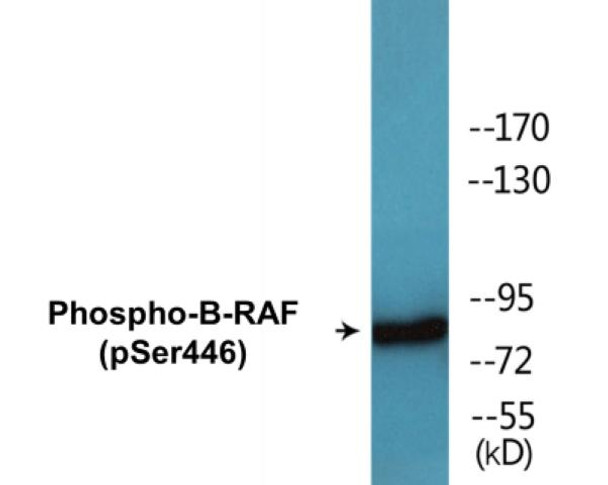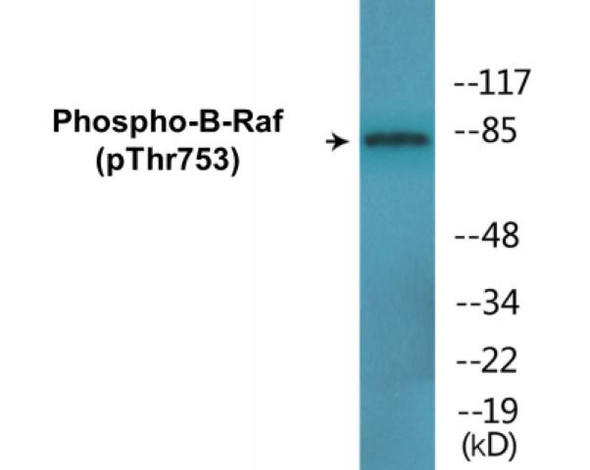B-RAF (Phospho-Ser446) Colorimetric Cell-Based ELISA Kit
- SKU:
- CBCAB01641
- Product Type:
- ELISA Kit
- ELISA Type:
- Cell Based Phospho Specific
- Reactivity:
- Human
- Mouse
- Detection Method:
- Colorimetric
Description
B-RAF (Phospho-Ser446)Colorimetric Cell-Based ELISA Kit
The B-Raf Phospho-Ser446 Colorimetric Cell-Based ELISA Kit from Assay Genie is a powerful tool for researchers studying cell signaling pathways and phosphorylation events. This kit specifically detects phosphorylation of B-Raf at Ser446, providing valuable insights into the activation status of this important kinase.With high sensitivity and specificity, this kit delivers accurate and reproducible results, making it ideal for a wide range of applications in cancer research, drug development, and more. B-Raf is a key player in the MAPK signaling pathway, and aberrant phosphorylation events can contribute to oncogenesis and tumor progression.
By monitoring phosphorylation at Ser446, researchers can gain a deeper understanding of B-Raf signaling dynamics and potentially identify new therapeutic targets.Whether investigating cancer biology, drug resistance mechanisms, or cell signaling pathways, the B-Raf Phospho-Ser446 Colorimetric Cell-Based ELISA Kit offers a reliable and efficient solution for studying phosphorylation events in a cell-based context. Trust Assay Genie for high-quality ELISA kits that drive groundbreaking research and discovery.
| Product Name: | B-RAF (Phospho-Ser446) Colorimetric Cell-Based ELISA |
| Product Code: | CBCAB01641 |
| ELISA Type: | Cell-Based |
| Target: | B-RAF (Phospho-Ser446) |
| Reactivity: | Human, Mouse |
| Dynamic Range: | > 5000 Cells |
| Detection Method: | Colorimetric 450 nm |
| Format: | 2 x 96-Well Microplates |
The B-RAF (Phospho-Ser446) Colorimetric Cell-Based ELISA Kit is a convenient, lysate-free, high throughput and sensitive assay kit that can detect B-RAF protein phosphorylation and expression profile in cells. The kit can be used for measuring the relative amounts of phosphorylated B-RAF in cultured cells as well as screening for the effects that various treatments, inhibitors (ie. siRNA or chemicals), or activators have on B-RAF phosphorylation.
Qualitative determination of B-RAF (Phospho-Ser446) concentration is achieved by an indirect ELISA format. In essence, B-RAF (Phospho-Ser446) is captured by B-RAF (Phospho-Ser446)-specific primary (1ø) antibodies while the HRP-conjugated secondary (2ø) antibodies bind the Fc region of the 1ø antibody. Through this binding, the HRP enzyme conjugated to the 2ø antibody can catalyze a colorimetric reaction upon substrate addition. Due to the qualitative nature of the Cell-Based ELISA, multiple normalization methods are needed:
| 1. | A monoclonal antibody specific for human GAPDH is included to serve as an internal positive control in normalizing the target absorbance values. |
| 2. | Following the colorimetric measurement of HRP activity via substrate addition, the Crystal Violet whole-cell staining method may be used to determine cell density. After staining, the results can be analysed by normalizing the absorbance values to cell amounts, by which the plating difference can be adjusted. |
| Database Information: | Gene ID: 673, UniProt ID: P15056, OMIM: 114500/115150/164757/211980/605027, Unigene: Hs.550061 |
| Gene Symbol: | BRAF1 |
| Sub Type: | Phospho |
| UniProt Protein Function: | BRAF: a tyrosine kinase-like kinase of the RAF family. Involved in the transduction of mitogenic signals from the cell membrane to the nucleus. May play a role in the postsynaptic responses of hippocampal neuron. Frequently mutated in thyroid cancers, skin melanomas and at lower frequency in a wide range of human cancers. An activating mutation, mimicking phosphorylation of the activation loop, is seen in 60% of malignant melanoma samples. Raf mutations are generally exclusive to Ras activating mutations. Activating mutations are also seen in ~10% of colorectal cancers, in lung cancers and gliomas, and at a lower rate in several other tumors. Inactivating mutations are also seen and may result in activation of c-Raf and Erk. Mutations in B-Raf, MEK1 and MEK2 also associated with cardiofaciocutaneous syndrome, displaying morphological, cardiac and mental defects. Approved Inhibitor: Nexavar/Sorafenib. |
| UniProt Protein Details: | Protein type:Kinase, protein; Protein kinase, Ser/Thr (non-receptor); Protein kinase, TKL; Oncoprotein; EC 2.7.11.1; TKL group; RAF family Chromosomal Location of Human Ortholog: 7q34 Cellular Component: neuron projection; mitochondrion; plasma membrane; cytosol; nucleus Molecular Function:small GTPase binding; protein serine/threonine kinase activity; identical protein binding; protein binding; MAP kinase kinase kinase activity; mitogen-activated protein kinase kinase binding; protein heterodimerization activity; calcium ion binding; ATP binding; protein kinase activity Biological Process: positive T cell selection; response to peptide hormone stimulus; fibroblast growth factor receptor signaling pathway; response to cAMP; CD4-positive, alpha beta T cell differentiation; activation of MAPKK activity; nerve growth factor receptor signaling pathway; somatic stem cell maintenance; protein heterooligomerization; MAPKKK cascade; protein amino acid phosphorylation; positive regulation of peptidyl-serine phosphorylation; regulation of cell proliferation; synaptic transmission; organ morphogenesis; myeloid progenitor cell differentiation; small GTPase mediated signal transduction; positive regulation of stress fiber formation; visual learning; negative regulation of neuron apoptosis; negative regulation of apoptosis Disease: Noonan Syndrome 1; Noonan Syndrome 7; Lung Cancer; Cardiofaciocutaneous Syndrome 1; Leopard Syndrome 3 |
| NCBI Summary: | This gene encodes a protein belonging to the raf/mil family of serine/threonine protein kinases. This protein plays a role in regulating the MAP kinase/ERKs signaling pathway, which affects cell division, differentiation, and secretion. Mutations in this gene are associated with cardiofaciocutaneous syndrome, a disease characterized by heart defects, mental retardation and a distinctive facial appearance. Mutations in this gene have also been associated with various cancers, including non-Hodgkin lymphoma, colorectal cancer, malignant melanoma, thyroid carcinoma, non-small cell lung carcinoma, and adenocarcinoma of lung. A pseudogene, which is located on chromosome X, has been identified for this gene. [provided by RefSeq, Jul 2008] |
| UniProt Code: | P15056 |
| NCBI GenInfo Identifier: | 50403720 |
| NCBI Gene ID: | 673 |
| NCBI Accession: | P15056.4 |
| UniProt Secondary Accession: | P15056,Q13878, Q3MIN6, Q9UDP8, Q9Y6T3, A4D1T4, B6HY61 B6HY62, B6HY63, B6HY64, B6HY65, B6HY66, |
| UniProt Related Accession: | P15056 |
| Molecular Weight: | 84kDa |
| NCBI Full Name: | Serine/threonine-protein kinase B-raf |
| NCBI Synonym Full Names: | B-Raf proto-oncogene, serine/threonine kinase |
| NCBI Official Symbol: | BRAF |
| NCBI Official Synonym Symbols: | NS7; BRAF1; RAFB1; B-RAF1 |
| NCBI Protein Information: | serine/threonine-protein kinase B-raf; 94 kDa B-raf protein; proto-oncogene B-Raf; v-raf murine sarcoma viral oncogene homolog B; v-raf murine sarcoma viral oncogene homolog B1; murine sarcoma viral (v-raf) oncogene homolog B1; B-Raf proto-oncogene serine/threonine-protein kinase (p94) |
| UniProt Protein Name: | Serine/threonine-protein kinase B-raf |
| UniProt Synonym Protein Names: | Proto-oncogene B-Raf; p94; v-Raf murine sarcoma viral oncogene homolog B1 |
| Protein Family: | Serine/threonine-protein kinase |
| UniProt Gene Name: | BRAF |
| UniProt Entry Name: | BRAF_HUMAN |
| Component | Quantity |
| 96-Well Cell Culture Clear-Bottom Microplate | 2 plates |
| 10X TBS | 24 mL |
| Quenching Buffer | 24 mL |
| Blocking Buffer | 50 mL |
| 15X Wash Buffer | 50 mL |
| Primary Antibody Diluent | 12 mL |
| 100x Anti-Phospho Target Antibody | 60 µL |
| 100x Anti-Target Antibody | 60 µL |
| Anti-GAPDH Antibody | 60 µL |
| HRP-Conjugated Anti-Rabbit IgG Antibody | 12 mL |
| HRP-Conjugated Anti-Mouse IgG Antibody | 12 mL |
| SDS Solution | 12 mL |
| Stop Solution | 24 mL |
| Ready-to-Use Substrate | 12 mL |
| Crystal Violet Solution | 12 mL |
| Adhesive Plate Seals | 2 seals |
The following materials and/or equipment are NOT provided in this kit but are necessary to successfully conduct the experiment:
- Microplate reader able to measure absorbance at 450 nm and/or 595 nm for Crystal Violet Cell Staining (Optional)
- Micropipettes with capability of measuring volumes ranging from 1 µL to 1 ml
- 37% formaldehyde (Sigma Cat# F-8775) or formaldehyde from other sources
- Squirt bottle, manifold dispenser, multichannel pipette reservoir or automated microplate washer
- Graph paper or computer software capable of generating or displaying logarithmic functions
- Absorbent papers or vacuum aspirator
- Test tubes or microfuge tubes capable of storing ≥1 ml
- Poly-L-Lysine (Sigma Cat# P4832 for suspension cells)
- Orbital shaker (optional)
- Deionized or sterile water
*Note: Protocols are specific to each batch/lot. For the correct instructions please follow the protocol included in your kit.
| Step | Procedure |
| 1. | Seed 200 µL of 20,000 adherent cells in culture medium in each well of a 96-well plate. The plates included in the kit are sterile and treated for cell culture. For suspension cells and loosely attached cells, coat the plates with 100 µL of 10 µg/ml Poly-L-Lysine (not included) to each well of a 96-well plate for 30 minutes at 37 °C prior to adding cells. |
| 2. | Incubate the cells for overnight at 37 °C, 5% CO2. |
| 3. | Treat the cells as desired. |
| 4. | Remove the cell culture medium and rinse with 200 µL of 1x TBS, twice. |
| 5. | Fix the cells by incubating with 100 µL of Fixing Solution for 20 minutes at room temperature. The 4% formaldehyde is used for adherent cells and 8% formaldehyde is used for suspension cells and loosely attached cells. |
| 6. | Remove the Fixing Solution and wash the plate 3 times with 200 µL 1x Wash Buffer for five minutes each time with gentle shaking on the orbital shaker. The plate can be stored at 4 °C for a week. |
| 7. | Add 100 µL of Quenching Buffer and incubate for 20 minutes at room temperature. |
| 8. | Wash the plate 3 times with 1x Wash Buffer for 5 minutes each time. |
| 9. | Add 200 µL of Blocking Buffer and incubate for 1 hour at room temperature. |
| 10. | Wash 3 times with 200 µL of 1x Wash Buffer for 5 minutes each time. |
| 11. | Add 50 µL of 1x primary antibodies Anti-B-RAF (Phospho-Ser446) Antibody, Anti-B-RAF Antibody and/or Anti-GAPDH Antibody) to the corresponding wells, cover with Parafilm and incubate for 16 hours (overnight) at 4 °C. If the target expression is known to be high, incubate for 2 hours at room temperature. |
| 12. | Wash 3 times with 200 µL of 1x Wash Buffer for 5 minutes each time. |
| 13. | Add 50 µL of 1x secondary antibodies (HRP-Conjugated AntiRabbit IgG Antibody or HRP-Conjugated Anti-Mouse IgG Antibody) to corresponding wells and incubate for 1.5 hours at room temperature. |
| 14. | Wash 3 times with 200 µL of 1x Wash Buffer for 5 minutes each time. |
| 15. | Add 50 µL of Ready-to-Use Substrate to each well and incubate for 30 minutes at room temperature in the dark. |
| 16. | Add 50 µL of Stop Solution to each well and read OD at 450 nm immediately using the microplate reader. |
(Additional Crystal Violet staining may be performed if desired – details of this may be found in the kit technical manual.)










